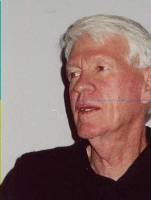


Venomous Country
Participants
Venomous Country
Endnotes
Index
Search
Help
Contact us

Ken Winkel: Perhaps now we should briefly discuss an issue that no-one has mentioned, that is competition with Struan's ideas and his interaction with those who had a slightly different view. I was particularly wondering about the work of Ron Atkinson at Darling Down who was at one point in the headlines as a competitor with a potential alternative antidote to compete with Struan's funnel web spider antivenom. How did Struan view competitors in general and in this particular case? Any comments from those who have memories of that particular event.
John Williamson: There was another personality conflict involving Struan's career that should be mentioned. Again, if Struan was here he would support this. Dr Julian White[65] in Adelaide and Struan just didn't see eye to eye. This was, and is, most unfortunate because both these people had a great deal to offer. I've had quite a deal to do with my colleague and friend Julian over the last ten years. There's no doubt he's made major contributions to the understanding of toxinology, not only in Australia but internationally. But the fact is he can be just as difficult as Struan was in some ways. And I tried for years to build a bridge between them, but did not succeed. I'm sure Jim knows something about this.

Photograph courtesy of Ann Westmore
John Williamson: Julian knows this [seminar] is happening today and he sends his very best wishes. And I know for a fact that each of these men had a healthy respect for the other. It was never mentioned in my hearing at least; but I know that existed. This unfortunate personality conflict worked to the disadvantage of Australian advances in this field.
Julian is the most expert person I know in the world regarding Australian brown snake envenomation. And clinically, he is magnificent. He is superb. If I am bitten by a brown snake, Julian is going to be involved as quickly as possible, I assure you.
Ken Winkel: Perhaps now we'll accelerate towards the challenges for the future. We've heard from Jim about how Struan finished at the University. I know Jim that, a few years, ago the Irukandji project seemed like it had reached a dead end and you wanted to give up. But I didn't tell Struan that, and we persisted And I wondered if you would comment on how far you think we've come with the Irukandji story and the challenges you see for the future in the pharmacology of venoms.
Jim Angus: First of all, Heads of Departments can make mistakes. However when there was so little material and it seemed to be in different batches, we never had enough to actually do something definitively. And it comes back to the robustness of your data. Instead of just doing anecdotal experiments, one after the other, which give you slightly different data, never enough to get the group and get a good average response. That's why I was concerned.
But I'm pleased to say that because of the recent swarm that we had in Queensland, we have got enough material. We've made enormous advances in trying to understand Irukandji syndrome.[66] And, in fact one of my jobs this weekend is to put the finishing touches to a paper which defines for the first time the pharmacology of this particular venom.[67] There's still a lot of work to be done, but what I think the underlying point here is that we have to be persistent and make use of your opportunities and collaborate. We could not do this [project] from Melbourne because of the tyranny of distance. We require the life-savers in Queensland to help us and talk to each other. This whole idea about competition [needs to be re-examined]. Yes, it's healthy in science but for Australia, this is our problem, we are Australians and we've got to solve it. No-one else will.
 |
Witness to the History of Australian Medicine |  |
© The University of Melbourne 2005-16
Published by eScholarship Research Centre, using the Web Academic Resource Publisher
http://witness.esrc.unimelb.edu.au/087.html